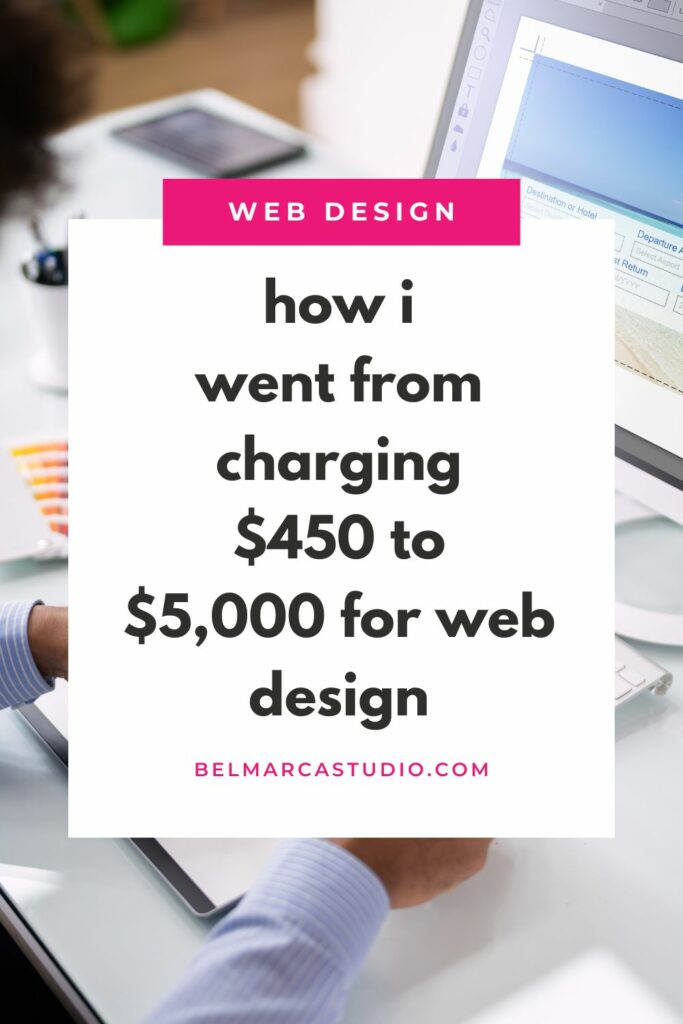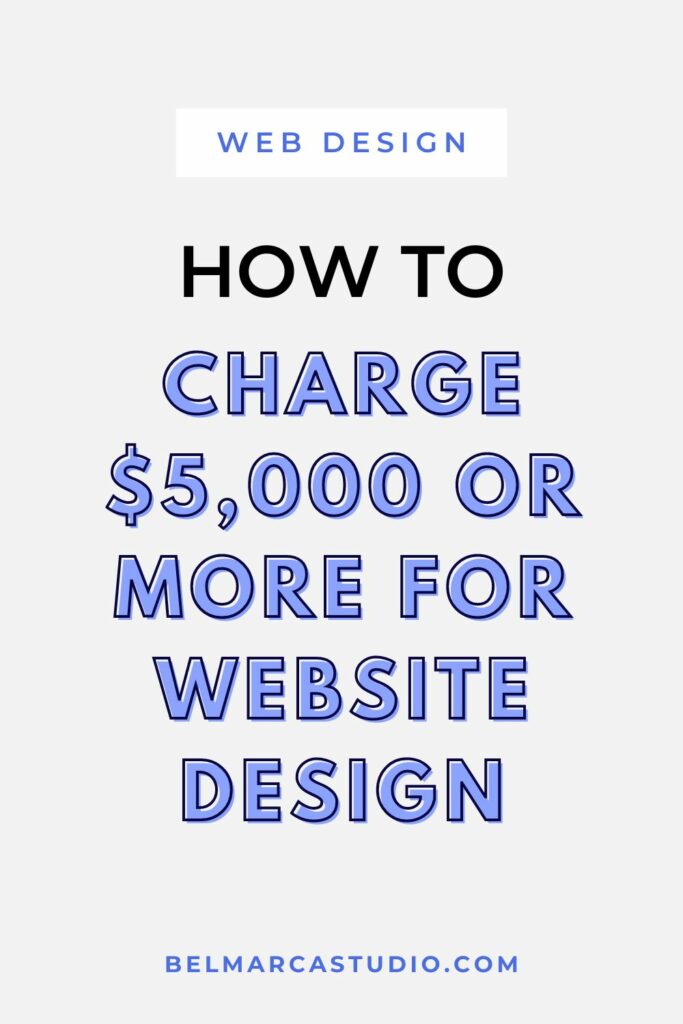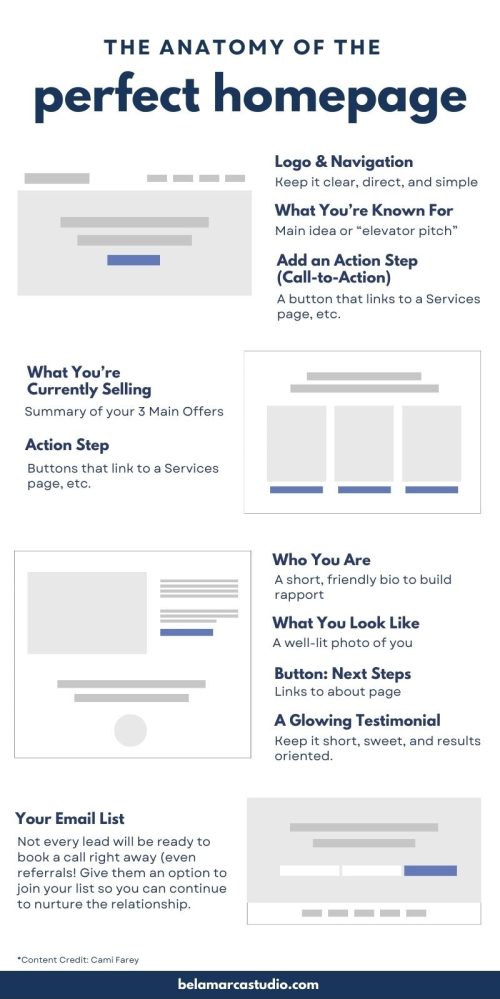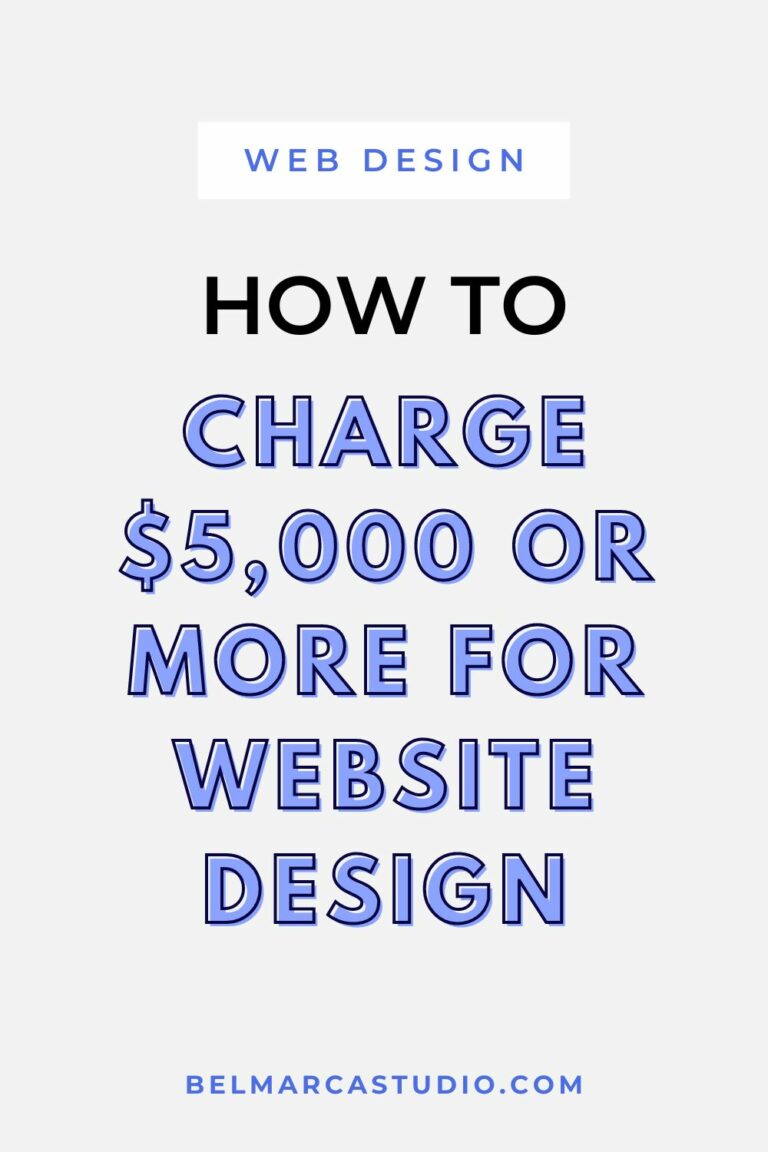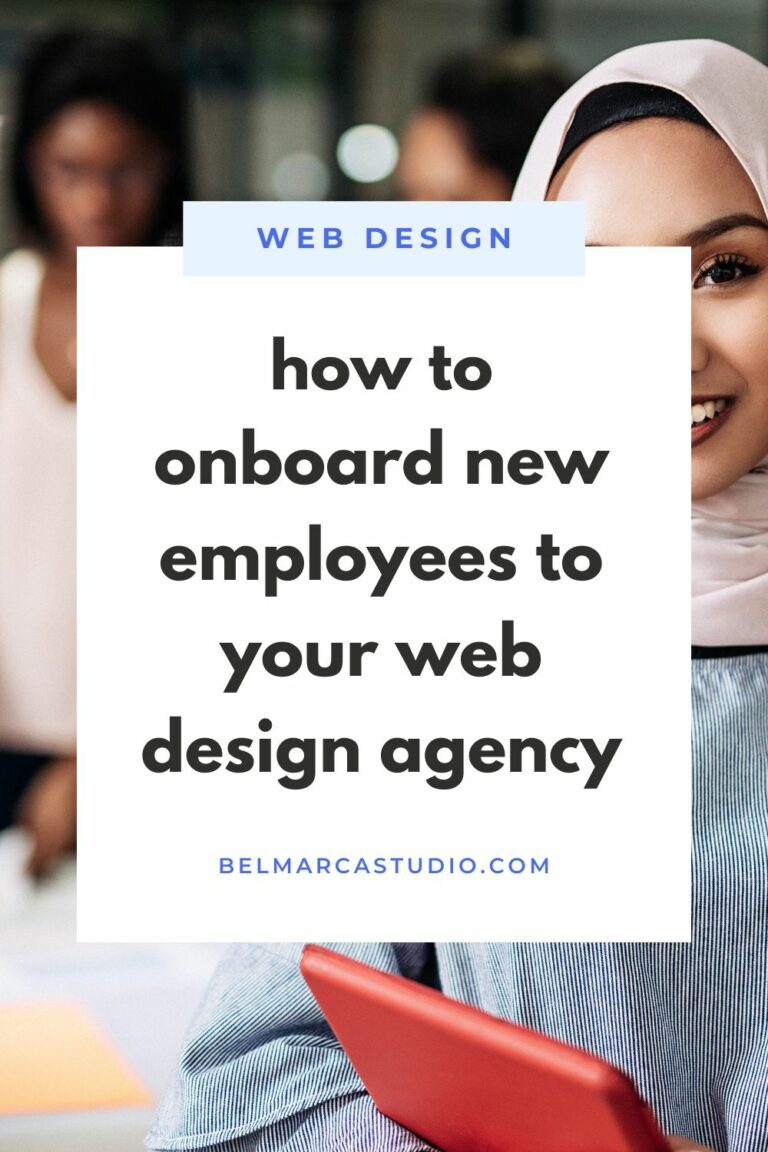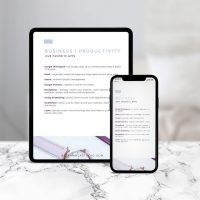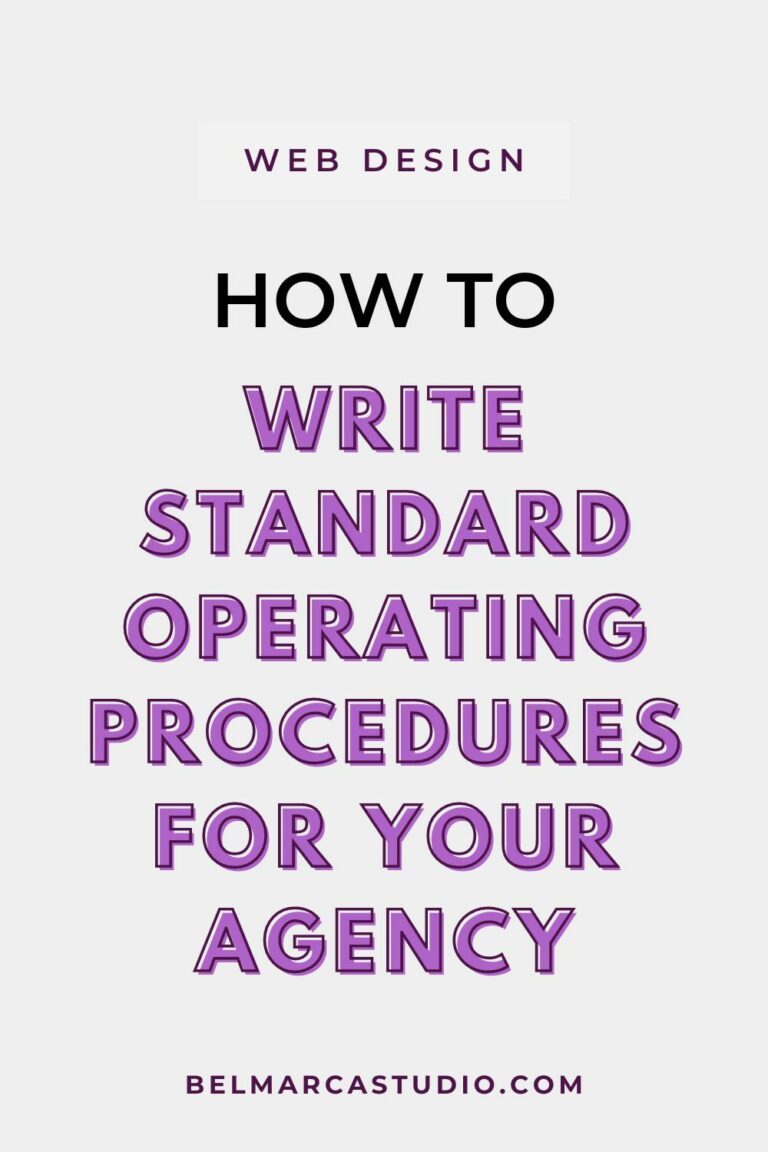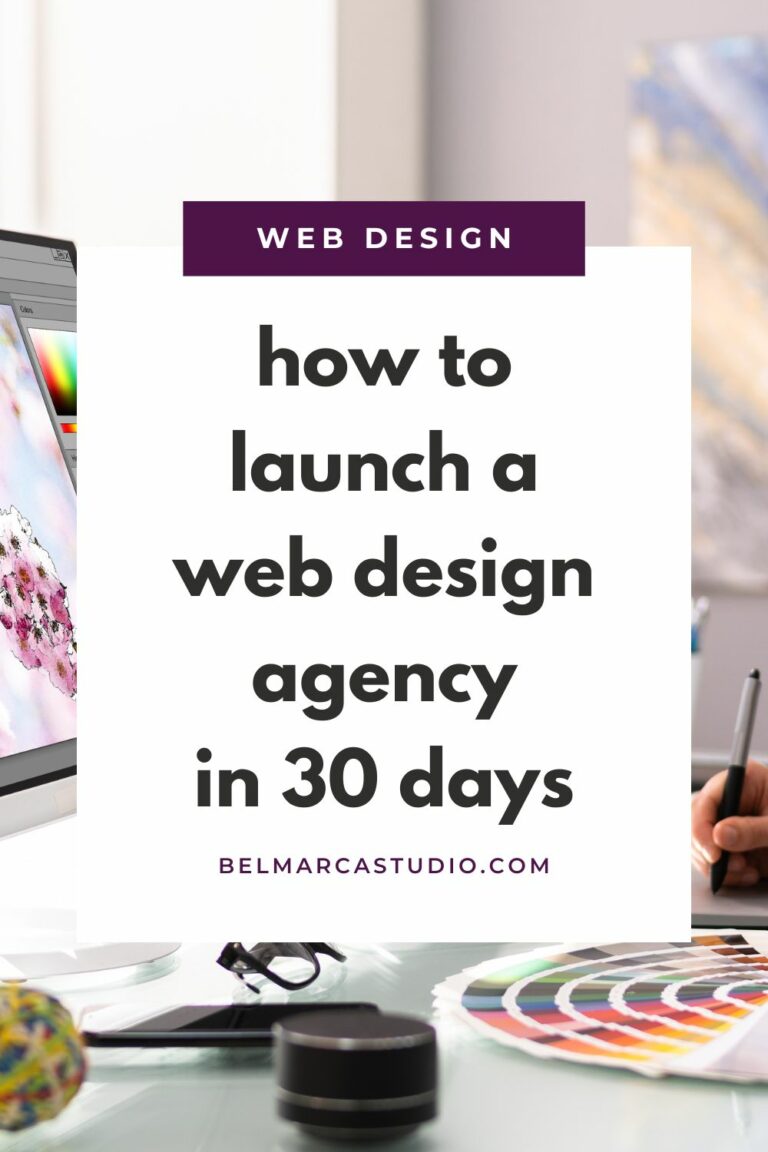Picture this: you’re just getting started as a web designer and with your current pricing, you’re reaching the point of burnout. Your goal is to earn $5000/month, but you can’t imagine ever charging that for a single project. Or maybe you’ve been designing web sites for a while, but you’re nervous that you don’t have the design skills you need to charge premium prices with confidence. Or maybe you’ve been in business for a while, you’re fairly established at this point, but you’re afraid to raise your rates and lose your clients to someone cheaper.
No matter which one of those you relate to, you wish you could charge $5,000 or more for your website projects with complete confidence. You want to work with fewer clients, work with better clients, you want to create more freedom for yourself and hit your income goals. Keep reading to learn how to charge $5,000 or more for web design!
Here’s what we’re covering in this post:
- The strategic secrets to charging $5,000 or more for your websites
- The money mindset you need to charge more
- The strategic website design plan for conversions
- The anatomy of the perfect homepage
- How and where to showcase your client testimonials
- My favorite platform to create gorgeous high end websites
Let’s be clear that there is nothing wrong with charging $450 for a website. We all have to start somewhere. But when you start to do the math, it doesn’t add up to a happy ending. When I was starting out, I quickly realized that at this price point, I would need a ton of clients.
For example, if you want to replace a salary of about $45K, you’d need 100 web design clients a year. That is not fun, trust me. Now if you’re self-employed, you have to consider taxes and health insurance and retirement etc. So to earn a more comfortable living for somebody self-employed, let’s say in New York earning $80K/month, in which case you would need 177 clients that year. To take it a step further, if you wanted to make six figures, you would need 222 clients in the year. These numbers are absolutely terrible, right?
So why is $5,000 per project the golden number? It doesn’t just mean more money. It means more freedom, more time, and getting to work with clients that you’ll love. Plus, the math looks way better. To replace your corporate income at this rate, you would only need 9 clients. To earn that comfortable living, you’d need 16 clients a year. And then to make six figures, you’d only need 20 clients a year. And that’s assuming that all your clients are only paying $5,000 as a starting price. Does this sound doable in your business?
None of this works if you don’t change your mindset. Stop thinking like a freelancer and start thinking like a business owner. When a client hires me for a project, that project is an investment, not an expense. It’s not money that they’re never going to get back. It’s money that they’re going to be able to multiply.
For example, think of the difference between paying rent and buying a house. Paying rent is an expense paid every month. You’ll never see that money again and you’re always looking to get it for cheaper. That’s because it’s an expense. Now, when something’s an investment like buying a house, our mindset changes. What we want is the best, not the cheapest. We want a house that’s going to appreciate over time, that’s going to serve our families well, that’s going to make us money in the end. So you’re typically not looking for the cheapest property. You’re looking for the property that has the best value.
It’s the same for you with your design projects. The first niche I served was entrepreneurs and individuals starting their first businesses from scratch. The value of a website to a bootstrapper isn’t as obvious as it is to a small business owner because the return on investment just isn’t as clear. And so the website starts to feel like an expense for them, and therefore it feels expensive. Now, I work with service-based business owners and personal brands, and the value of a website is really clear to them, because often the website is going to pay for itself within two to three clients. So because the ROI of the project is clear, suddenly a $5,000 website feels like a really exciting investment in the future of your business. The takeaway from this is that you have to stop thinking like a freelancer and position all of your marketing as an investment and not an expense.
Remember, If you’ve chosen your target niche but you’re nervous that this pricing may be too expensive for said audience, think about what they charge per hour and what they want out of their website. Sometimes it’s a monetary ROI and sometimes it’s more intangible and as simple as wanting to look better than their competitors so they can build confidence in themselves. That hold’s value as well. If someone is willing to pay $2,500 for a website, chances are they’ll pay $5,000 for a website. Sometimes the limitation is in our brain. The reality is there are niches that are a little more challenging than others. You can sell premium in any niche imaginable as long as you position yourself correctly. Don’t assume what someone can or can’t afford. There are people who can afford all price points. Just focus on what you do best, which is web design!
The number one skill you need to charge premium prices for web design is strategic design. All it means is that you are going to plan your client’s website around their goals before diving into the visuals. You can pull off strategic design no matter what level of design experience you may have. It’s a very simple process. Fill in the blanks of this statement: “I offer____, _____ and _____. And I want people to hire me by doing _____.”
So let’s imagine that you’re building a website for a photographer. Your photographer client might say something like, “I offer family portrait sessions, newborn photography sessions, and mini sessions. And I want people to hire me by coming to my website and booking a call.” So using that sentence, you’re going to reverse engineer your client’s website for sales and get them that ROI. Use that one sentence to set the website’s main goal, to get clear on the tech functionality needed to map out all of the pages, and figure out how you’re going to guide visitors to action and get them from point A to point B.
First up, setting the site’s main goal. Ask your clients: “What’s the most important action a visitor can take on this website?” Their answer was: “I want people to hire me by visiting my website and booking a call.” So that’s your goal, the most important action is to book a call so the photographer can get hired and make sales. Next, you need to have a clear idea of the tech functionality you’ll need. What does this website need to do to achieve our goal? It needs to integrate with some kind of scheduling software like Acuity Scheduling.
After that, you need to plan out the website’s pages and content. What do your visitors need to see and read on your website to help them take the action that you’ve defined? The photographer’s website visitors need to know who she is, what she offers, why she’s the best for the job and how to get in touch. This translates well to a homepage, about page, services page, a portfolio page, a blog, a testimonials page, and of course a contact page. Now we need to figure out how we’re going to get the website visitors to take action and book a call. Possibly, someone could land on the homepage, navigate to the services page and then from there they could book a call. So be sure to plan out some of these pathways for your projects as well as your own website. Remember, you don’t need to be the fanciest designer out there, you just need to be strategic.
Download this step-by-step itemized checklist that covers each step needed to launch your agency. Plus all the steps to complete each segment of your client projects, and a list of quality assurance points so you nail each project delivery.
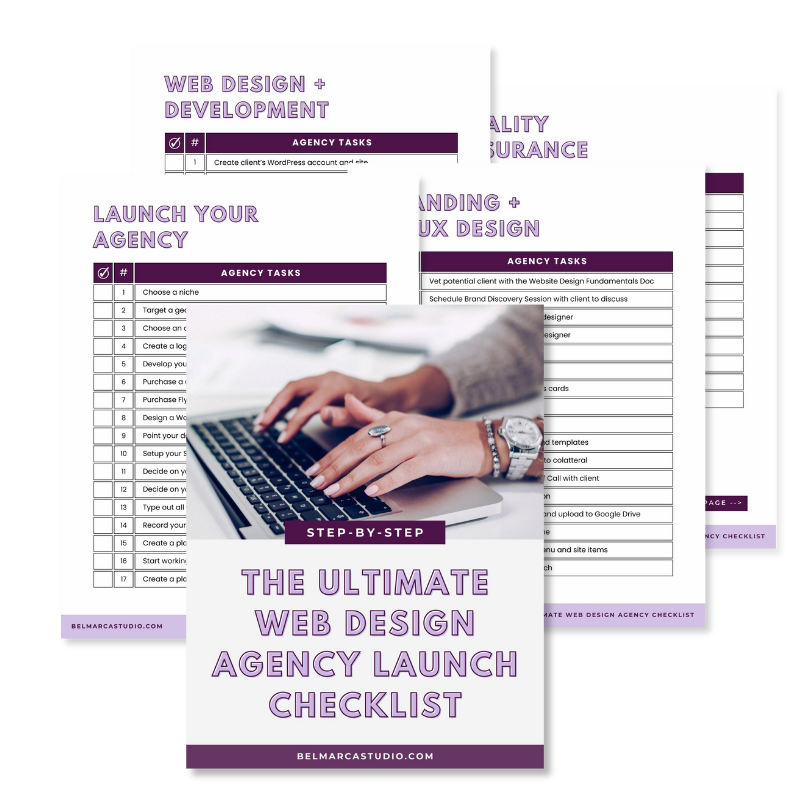
Let’s take it a step further. Perhaps your client gets most of her leads through word of mouth referrals. You should plan a homepage that’s strategically designed to help her turn those referrals into clients. Think of the homepage as the first date of a website. This is where you introduce yourself, they get to know you a little bit and then you invite them to take a next step with you. On this page we’re going to be directing people to check out her services and then book a call with her. Check out the infographic below:
In the first area, add your client’s main idea or her elevator pitch, and then give it an action step. So for that photographer client, this would be a perfect place to link to her services page. For example, you could say: “Scale your business and finally become the CEO you’re meant to be with our expert business management team. Click here to see how we can help.” It’s a short, sharp elevator pitch with a button that leads to their services page where we can learn more.
Next you’ll want to summarize your three main offers, which is what your client is currently selling, and then the action step is going to be buttons that link to the services page or link to the individual package pages for that offering. For example, you can include a high, medium and low package, summarizing them nicely so that someone can see at a glance what they offer, click the button to get more info and then book a call with her right away.
In the next section, after the offerings, follow up with a short friendly bio and a photo to build rapport. And then a button that links to the about page. This allows site visitors to go check out who’s behind this website and make sure that this photographer is a real person who they would want around their family or at their wedding.
After that, follow it up with a glowing testimonial, something short and sweet and results oriented so that people who are visiting the website can see that your client is as awesome as she claims and here’s somebody else saying it as proof.
Now finish it up with an email list, because not every lead is gonna be ready to book a call right away, even really warm referral traffic. So give them an option to join your list, so you can continue to nurture that relationship. And there you have it, a simple step-by-step blueprint for a homepage that’s designed around the goal of turning referral word of mouth traffic into clients.
The takeaway here is that the strategic design we just walked through is the number one most important skill you need to master if you wanna charge premium pricing, because it really helps your clients see the value of your work. You’re not just building them a pretty website, you’re building them a website that’s been engineered from the ground up to get them to a certain outcome.
A simple design trick that’s going to help you promote your services without seeming desperate and without sounding like a cheesy infomercial is strategically showcasing testimonials. When you pair great images of yourself with great testimonials, your potential clients will view you as their guide, their person to solve their problems. So testimonials are going to help you sell your services because they do all of the convincing for you. And so while you can’t guarantee people results, testimonials are going to help your future clients understand what’s possible for them when they hire you and understand the value of your services.
Here’s an example of a nice but lackluster testimonial. It says: “Overall working with Gregoria was a wonderful experience. She’s an extremely talented woman with an amazing eye for design and I love my new website.” This testimonial would make any designer feel special, but it’s not going to help you sell premium websites to future clients because it’s not showing a transformation. A transformation can be shown in a lot of different ways. A transformation can be shown through feelings, like this for example: “Before hiring Gregoria, I didn’t want to show my website because of embarrassment. Today, I’m happily sharing my site, it feels awesome.” So we’ve got the before, which is the embarrassment, and the after, which is happily sharing. And that’s a really valuable transformation that’s based in the client’s feelings and her experience.
A transformation shown through any results achieved or real-time data is great for a testimonial. One trick when you’re reviewing your client’s Google Analytics, is to pull some of their numbers and then send them an email saying something like: “Hey, I just looked at your analytics and I noticed that we boosted your email options by 43% in a month and up to a web traffic by 300% since we launched. Is it cool if I use that in a testimonial?” Your client will most likely reply saying how excited they are over those results and that you have their permission. It’s a win-win for both of you.
So now you know what makes a really good testimonial, it’s time to show them off. So the secret here is that you can actually get a ton of mileage out of your testimonials. So if you’re just starting out or if you only have a couple of really amazing ones that you want to broadcast everywhere, that’s more than enough. Because the more you share, the more selling your testimonials are going to do for you. So here a few different repurposing ideas to get mileage out of a single awesome testimonial:
- On your home page
- On a testimonials page
- As a case study that’s linked to your portfolio page
- Feature it in a blog post
- Feature it in an email to your email list
- Turn it into an instagram story and then save it to your highlights
- Turn it into a series of instagram posts or a carousel post
- Turn those same instagram posts into facebook posts and tweets on Twitter X
- Create a new Pinterest board dedicated to your testimonials and create new pin graphics that feature your reviews.
Related Article: How To Land Client Testimonials Without Begging
Related Article: How Case Studies Can Transform Your Agency Marketing
The takeaway for you is to sell your services and attract those premium high-end clients without sounding like an infomercial. Take your very best testimonials and put them absolutely everywhere, share them far and wide. When you repeat yourself in your business, it’s not being repetitive, it’s being on-message.
Let’s talk about my favorite platform to create gorgeous high-end websites. I firmly believe in using what’s best for you and your clients and that looks different for every designer. I myself started out on Wix and Squarespace and that was great for getting my feet wet and putting out simple websites. But that’s what they were, simple and bland and all looking the same.
Now we exclusively offer WordPress web design using our favorite page builder Elementor and we have no regrets. Now there are a lot of opinions out there about page builders, but here’s the thing. To start, you do not need to build websites from scratch for them to be valuable to your clients. Using a page builder tool like Elementor isn’t cheating. Page builders are tools that make your life easier, makes your clients lives easier, and they are an amazing solution that most of your clients want and expect. They add value to your projects, they don’t take value away.
Just like when hiring a photographer or a caterer, I don’t really care what camera or utensils they’re using as long as the result I’m paying for is amazing. So if you specialize in a specific platform like I do, you might have people asking you for that platform in particular, but you might also have a lot of clients who are coming to you who just want a solution to their problems. And it’s your job to use the tech tools that you feel are best to solve their problems.
WordPress with Elementor is awesome for me too, because it helps me save a ton of time as a designer. I’m not reinventing the wheel or researching a ton of new things for each project, which means that each project I do is more and more profitable because I can do it in less time. I can find great themes and templates on Creative Market and Envato Elements. I also increase my revenue by offering monthly WordPress hosting to my clients through Flywheel.
The takeaway here is that if you want to charge $5,000 or more for your projects, you can do that on any tech tool, on any platform you want. I want you to focus on working with the platform that’s the best solution for your clients’ problems, and also that’s the best match for you as a designer.
These are all things that I’ve personally done myself, tried and tested to go from charging $500 bucks to $5,000 or more. If I can do it, I promise that you can as well.
You’ve probably wondered…
Do you always have a free sales call with potential clients? A lot of the people are screened out before hopping on a call when they fill out my inquiry form I send them a intro packet. But I do like to have a brief call with the client just so I can figure out if they’re somebody that I want to work with. The sales call is often as much for me as it is for them.
Do clients still approach you looking for cheaper prices? Your website needs to not only be your hype man, but also your bouncer. So if you’re doing it right, it should be filtering out people who aren’t a good fit to work with you. And this could be through listing prices, starting-at prices, etc. It could be through having a section on your website that says: “You’re my perfect client if a, b, and c. You’re not my perfect client if a, b, and c.” I personally think there is nothing more awkward than being on a sales call with someone who’s expecting something to cost $250 and it really costs like $5,000 and it’s just a horrible experience for everybody. Transparency is key.
Any tips on finding your first few premium clients when breaking into your niche? I recommend finding people who are already serving the higher-end part of your niche and having coffee chats and connecting. You can say something like: “Hey, Lauren, I see that you work with photographers. Can we get together and have coffee online?” You set up a 30 minute call, get to know each other, and figure out if there’s some way that you can kind of collaborate and work together.
Reach out to three people per week until you’re booked out. And then you can cut it down a bit. Not every single one is going to turn into a great relationships, but the ones that do will send you some great work. Keep a Google Doc or a spreadsheet of who you’ve emailed so that you’re not reaching out to the same individuals every single week. Every two or three months, follow up with them maybe about something you’ve seen them post recently. Just something to keep touching base and keep the connection alive.
At the end of the day, when your new connections get a client that aligns with your niche, they’ll think to recommend you when they are in need of web design. Word of mouth referrals are the best marketing tool you can ever have because you can talk about how great you are all day, but when it comes from somebody else, it’s much more convincing.
Don’t discredit those first couple of cheap clients that you served to get your feet wet. Those testimonials and referrals can be solid gold. So again, make sure that you’re getting testimonials from your current clients and that you’re asking them for referrals because you don’t know who they know. Don’t assume that all the people they know are just like them with the same budgets.
You’ve got all the tools you need to start charging premium prices and working with clients that you’ll actually love. But pricing isn’t all that goes into launching and running a successful web design agency. Imagine if you could get instant access to 100+ SOP docs and 40+ hours of step-by-step video training to help you launch a PROFITABLE web design studio, delegate your work, and travel the world while your business runs itself? If this is a must for you than you’ve got to dive in to the Web Design Studio Accelerator Course!

what's included
Video Lessons
You get access to the EXACT training videos and lessons we use to train staff, delegate tasks and free up time to focus on the big picture. It's the blueprint, from prospecting all the way to closing recurring revenue.
Source Files
The entire FOLDER of all source files including branding guidelines, logo templates, website design files, social media collateral, and so much more organized & prepped in Figma for you to use.
Docs / SOPs
Everything you would ever need is ready to go. You get the video trainings, step-by-step directions, the itemized lists and the Google Sheets we use to deliver award-winning website designs to clients.
Ready to grow your
web design studio?
Download this step-by-step itemized checklist that covers each step needed to launch your agency. Plus all the steps to complete each segment of your client projects, and a list of quality assurance points so you nail each project delivery.

Pin me!

Pin me!
